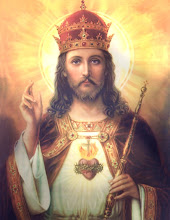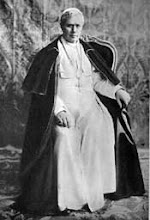Un amigo me llama la atención vía correo electrónico sobre esta entrada publicada (original aquí) hace unos meses en Tea at Trianon, una sugestiva bitácora católica confeccionada por Elena María Vidal en tierras del Quinto Imperio, el del Anticristo.
Creo que es momento de recuperar a San Malaquías. Sus acertadas profecías sobre los Pontífices le avalan. Lo que es más de temer es el año tope de 2012 que él pone. Año que San Malaquías considera el comienzo de algo distinto. Y como los comienzos suelen ser en baños de sangre de cristianos, bueno es tenerlo en cuenta.
Les dejo, sin más, con el original.
RCS
“But of this one thing be not ignorant, my beloved, that one day with the Lord is as a thousand years, and a thousand years as one day.” 2 Peter 3:8
“But of that day and hour no one knoweth, not the angels of heaven, but the Father alone.” Matthew 24:26
After I shared some reflections about the famous “Prophecy of St Malachy” a month or so ago (see The Prophecies of St. Malachy, Part 1 and Part 2) a reader sent me a book entitled La Mystérieuse prophétie des papes by Fr. René Thibaut, S.J. (Namur: Bibliothèque de la Faculté de philosophie et lettres,1951, Imprimatur: June 28, 1945, Et. Jos. Carton de Wiart) Fr. Thibaut (1883-1952) was a Belgian Jesuit and scholar who made a study of the list of popes attributed to St. Malachy. Fr. Thibaut’s research reveals that there is a great deal more to the Prophecy than I had ever imagined. It is a penetrating treatise which, because of the author’s vast knowledge of Church history and Sacred Scripture, both informs and inspires. The middle of the book is devoted to charts tracing the date of Easter over the years, and the leap years, as well as various ciphers, anagrams and acrostics with which, as Fr. Thibaut demonstrates, the list of Popes is imbued. Fr. Thibaut’s analysis becomes complex at that point although he explains his conclusions with clarity.
Fr. Thibaut maintains that the Prophecy of the Popes is a genuine prophecy. However, the identity of the actual prophet remains unclear. The author of the Prophecy is probably not St Malachy but someone who wrote under the name of the great Irish saint in order to honor him. (p.7) Fr. Thibaut insists that the Prophecy is not meant to worry or disturb but to reassure the faithful about the Providence of God during even the most difficult of times. It is a sort of litany which celebrates the glory and triumph of the universal Church throughout the ages under the leadership of the Roman pontiffs. (p.24) It was a mistake for people of the past (and present) to use the list of popes in order to predict who the next pope would be, for that was never the intention of the original author. (p.20) Neither is it meant to herald the imminent end of the world, because "of that day and hour no one knoweth, not the angels of heaven, but the Father alone." (Matthew 24:36)
According to Fr. Thibaut, the papal legate Nicholas Sanders (1530-1581) may have brought a primitive document containing the Prophecy to Rome during the reign of St. Pius V. Sanders spent a great deal of time in Ireland, which continued to be Catholic in spite of Elizabeth I. Sanders wrote De visibili Monarchia Ecclesiae in which he states that the reigns of the popes are the best “measure of time.” (pp. 23-24) Fr. Thibaut believes that the Prophecy, eventually made public by Wion in 1595, has qualities which indicate an older document of Celtic origin, namely due to the word play and the use of numbers in the various anagrams and acrostics. (p.92) Reading Fr. Thibaut’s explanation of the complex patterns of words and numbers embedded in the list reminds me of the intricacy of the Celtic knot work designs in the Book of Kells and other Irish illuminated manuscripts, albeit the intricacy is in numbers and letters rather than designs.
Of the 111 titles describing all the popes and anti-popes from 1143 to the present, Fr. Thibaut says that while the first 71 titles have been subjected to the tampering of a forger, the last 40, which cover the years 1572 to 2012, are untouched. The year of 2012 is repeatedly emphasized as coinciding with the last Pope on the list, called the “Glory of the Olive.” Fr. Thibaut demonstrates the calculation of the year 2012 on a series of charts. The last 40 popes of the genuine part of the prophecy span four centuries with an average of eleven years per reign, and so he calculates 440 years from 1572. 1572 +440 =2012. (pp. 22-23) Fr. Thibaut shows how the year 2012 keeps appearing in other calculations as well. He also insists that it will only be in the year 2012 that it will become clear whether his interpretation of The Prophecy is correct or not. (p.101)
Fr. Thibaut says that 2012 signifies the end of an era in the history of the Church, recalling how other eras have come and gone. The destruction of Jerusalem in A.D. 70 marked the close of an era, as did the fall of Rome in the fifth century. The fifteenth century saw the end of medieval Christianity with the Reformation. (p.22) The Revolutions of the eighteenth and nineteenth century as well as the World Wars of the twentieth century were events which manifested the judgment of God as well as signaling changes for the Church and the world. (pp. 88, 92, 96) Throughout such stages, the Church has been guided by the successors of St. Peter. (p. 22)
Speaking of St. Peter, the list concludes with the following phrase: "In the final persecution of the Holy Roman Church there will reign Peter the Roman, who will feed his flock amid many tribulations, after which the seven-hilled city will be destroyed and the dreadful Judge will judge the people.” Fr. Thibaut explains how “Peter the Roman” does not signify a future pope calling himself “Pope Peter II” but rather Petrus Romanus symbolizes all the Roman pontiffs since St. Peter, for the Church has continually undergone persecution of some kind. (p.25) The destruction of Rome will not necessarily follow immediately after the end of the era in 2012, but may come at a later date. (p.21) Nevertheless, Fr. Thibaut surmises that it is not unthinkable that at some point in the future the Popes may change their residence and govern the Church from somewhere other than the city of Rome. (p.22)
The final pope on the list is given the title Gloriae olivae, “The Glory of the Olive.” Fr. Thibaut says that the olive represents the people of God whom His judgment will glorify. (p.97) Once again, Fr. Thibaut insists that the Prophecy is genuine since so often in the last 400 years the titles have accurately described a pope and his reign, too many times for it to be pure chance. This is discussed in great detail and perhaps will be the topic of a future blog post. (To do full justice to such an exhaustive work is beyond the scope of one or two blog articles.) Fr. Thibaut ends by saying: L'année 2012 dira si, oui ou non, le prophête a vu clair. (p.101)
That remains to be seen.
Elena María Vidal
(RCS)
sexta-feira, outubro 02, 2009
San Malaquías y el año 2012
Publicada por
Rafael Castela Santos
à(s)
sexta-feira, outubro 02, 2009

Enviar a mensagem por emailDê a sua opinião!Partilhar no XPartilhar no FacebookPartilhar no Pinterest
Subscrever:
Enviar feedback (Atom)
















0 comentários:
Enviar um comentário